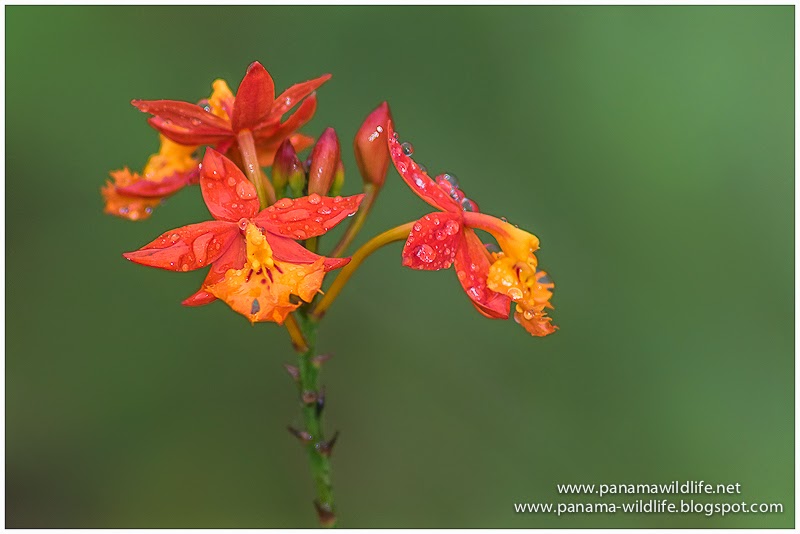Some weeks ago I headed to Palo Seco Protective Forest taking the hilly road to the Pump Station of the Trans-isthmian Pipeline owned by Petroterminal de Panama, in search of highland's birds (and snakes) for a project I'm working on. Unfortunately the day was cloudy, foggy and rainy. The small quantity of birds that I observed was difficult to photograph due to the weather conditions so I took advantage of the few minutes of sun to make photos of other interesesting stuff I found around (basically insects and flowers) with the 400mm lens.
Epidendrum radicans is a species of
orchid. Common names include ground-rooting epidendrum, fire-star orchid, rainbow orchid, and reed-stem epidendrum, and in Spanish "Estrella de Fuego". It is a
common roadside weed at middle elevations in Central America. It is a crucifix orchid. The diagnostic characteristic of E. radicans is its tendency to sprout roots all along the length of the stem.
It is a herbaceous plant of terrestrial habit (grows on the ground, not on trees), usually on rocks, being very variable, with long, fleshy aerial roots emerging from the stems.
It is found throughout Mexico, Costa Rica, El Salvador, Guatemala, Honduras, Nicaragua, Panama, Venezuela and Colombia, is common on rocks in full sun in the cloud forest, oak forest, evergreen tropical forest, riparian vegetation and evergreen bush
Purple flower of unknown plant
Squirrel Cuckoo (Piaya cayana), foraging on a fallen tree
The
Glasswinged Butterfly (Greta oto) is a
brush-footed butterfly, and is a member of the subfamily
Danainae. Adults exhibit a number of interesting behaviors, such as long migrations and
lekking among males. Adults range from Mexico through Panama and Colombia. They also fly through Florida.
The wings are transparent, with a span of 5.6 to 6.1 cm (2.2 to 2.4 in). The butterfly's most common English name is glasswinged butterfly, and its Spanish name is "espejitos" o "mariposa de cristal". Indeed, the tissue between the veins of its wings looks like glass, as it lacks the colored scales found in other butterflies. The opaque borders of its wings are dark brown, sometimes tinted with red or orange, and its body is dark in color.
These butterflies visit common flowers like
lantana, but prefer to lay its eggs on plants of the tropical Solanaceae genus
Cestrum. The green caterpillars feed on these toxic plants and are perhaps toxic to predators through secondary chemicals stored in their tissues. Adults are also assumed to be toxic, but their toxicity results mainly from males feeding on flowers (e.g.,
Asteraceae) whose nectar contains
pyrrolizidine alkaloids. These same alkaloids also are converted into
pheromones by the males and used to attract females.
Grasshopper (suborder Caelifera in the order Orthoptera) standing on a fern



Mimic Tigerwing (Melinaea lilis messatis). In 1848, English naturalist Henry Walter Bates was studying insects in the Amazon when he found that one butterfly was
mimicking the looks of another butterfly, solely to reap the protection of the other butterfly's looks. The butterfly that was being copied was known as the Heliconius ismenius, commonly called the Tiger-striped Long Wing Butterfly. The H. ismenius was being copied by Melinaea lilis messatis, common name Mimic Tigerwing. The H. ismenius are toxic and non-palatable to predators. They exemplify this by showing beautiful orange and black tiger stripes along the long wings. Predators remember these colors and patterns very quickly when they eat one of these butterflies, which make these warning colors quite desirable by other butterflies. Now, although the
pierids were palatable, they, as Bates would say, were the “mockers” mimicking the H. ismenius to better their survival. This study showed natural selection at its finest and was brought back by Bates just months after Charles Darwin published “On the Origin of Species”.

Zingiberaceae (ginger family). This is a family of
flowering plants made up of more than 1300 species of aromatic
perennial herbs with creeping horizontal or tuberous
rhizomes.
When I was leaving the place I observed several Blue-and-white Swallows
(Notiochelidon cyanoleuca), a species that breeds from Nicaragua south
throughout South America, except in the deserts and the Amazon Basin. In Central America, it is a highland bird, but elsewhere in its range it can occur from the lowlands to an altitude of 4,000 m (13,000 ft). They were flying, catching insects in the air as swallows usually do but then I observed where they were stopping under a ceiling in a stall on which they covered from the high winds, disregarding the heavy mist I was able to make a decent picture to ID the bird.
















Comments
Post a Comment